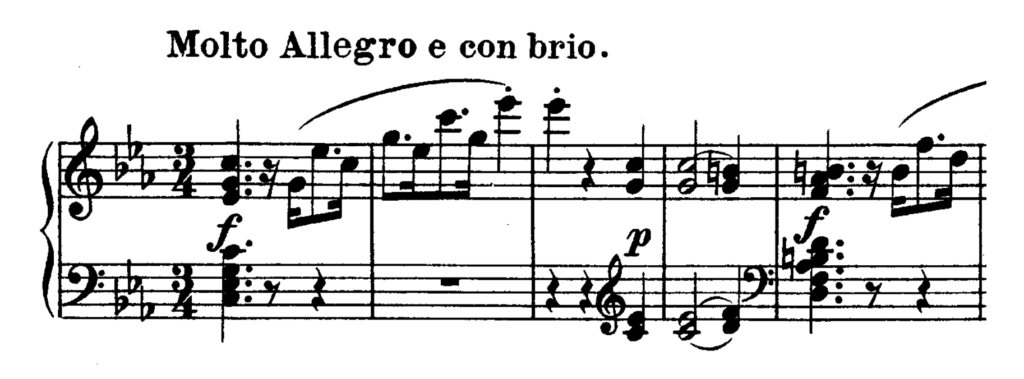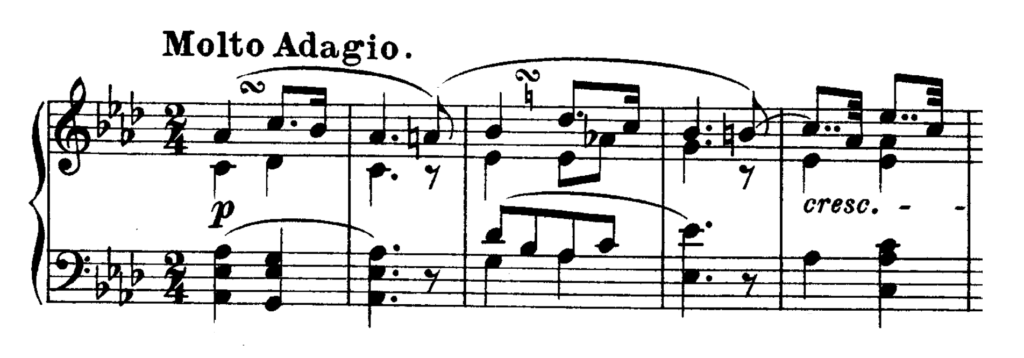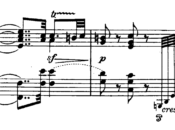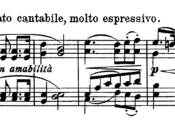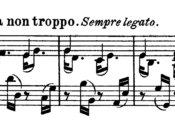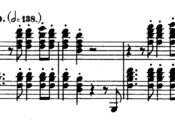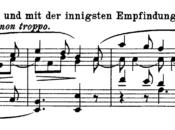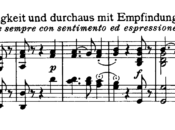Analysis
Contents
For the benefit of all pianists learning this work, we present to you a concise and easy to use analysis of Beethoven’s Piano Sonata No.5 in C minor.
First Movement (Allegro Molto E Con Brio )
Form: Sonata Form. C minor
EXPOSITION:
Bars 1-31: First subject in C minor (tonic). The first subject, which consists of nothing but tonic and dominant harmony of C minor, begins with two four-bar phrases, which are condensed to two-bar phrases at Bars 22-27.
Bars 32-56: Connecting Episode. The connecting episode (with one introductory bar on E flat) begins with a melodious phrase, which occurs three times, constructed upon the tonic and dominant harmony of the keys of A flat major, F minor, and D flat major respectively. After four bars of modulation there is a pedal point in the bass upon B flat for eight bars. Bar 45 contains three different forms of the chord of the augmented sixth (French, German, and Italian).
Bars 56-94: Second Subject in E flat major. The second subject is in four-bar rhythm. After the chord of the 6/4, Bar 86, there is a reminiscence of the first subject. It ends with full close in E flat major.
Bars 95-105: Coda. The Coda is formed upon the closing part of the connecting episode.
Double bar and repeat.
DEVELOPMENT:
Bars 106-168: The development commences with a part of the first subject in C major. At Bar 118 the second subject is developed for eight bars in F minor, repeated in B flat minor. These 16 bars contain nothing but tonic and dominant harmonies of the respective keys. Bars 136-167 form a passage taken from the connecting episode, leading to the re-entry of the first subject.
RECAPITULATION:
Bars 168-190: First Subject in original key. The first subject re-appears shortened, Bars 22-30 being omitted.
Bars 191-215: Connecting Episode. The first phrase of the original connecting episode is transposed from A flat major to G flat major, its first repetition from F minor to G flat major, and its second repetition from D flat major to E flat minor; the concluding part (pedal point) being upon the note C instead of B flat.
Bars 215-233: Second Subject in F major. The second subject re-appears shortened, and transposed into F major instead of into the tonic key C minor. At Bar 233, however, the whole subject recurs in the latter key.
Bars 233-271: And C minor (tonic).
Bars 271-End: Coda. The Coda is slightly altered and transposed into the tonic key.
The subdominant chord only occurs once throughout the whole of the principle subjects and Codas – viz. in Bar 72, subdominant of E flat (repeated bar 80, and of course in the Recapitulation).
Second Movement (Adagio Molto)
Form: Modified Sonata Form. Ab major
EXPOSITION:
Bars 1-16: First subject in A flat major (tonic). The first subject begins with two phrases of two bars each, followed by a phrase of four bars ending with half close on the dominant. These phrases are then repeated (varied), ending with full close in the tonic key.
Bars 17-24: Connecting Episode. The connecting episode commences with a two-bar phrase in B flat minor, repeated in A flat major; an imitation of it used to modulate to E flat major.
Bars 24-44: Second Subject in E flat major. The second subject begins with a four-bar phrase, Bars 24-27, repeated varied, Bars 28-31. This is followed by another phrase, Bars 31-35, which is also repeated (varied), ending with full close in E flat major, Bar 44.
DEVELOPMENT:
Bar 45: There is no development in this movement, its place being taken by simply an arpeggio chord of the dominant seventh, Bar 45.
RECAPITULATION:
Bars 46-61: First Subject (varied) in original key.
Bars 62-71: Connecting Episode. The connecting episode re-appears altered after the first three bars so as to end in the tonic key instead of the dominant. It is also elongated. Compare Bars 65-70 with Bars 20-23.
Bars 71-91: Second Subject in A flat major (tonic).
Bars 91-End: Coda. The Coda is formed upon the first subject; it contains syncopation in every bar but the last two.
Third Movement (Prestissimo)
Form: Sonata Form. C minor
EXPOSITION:
Bars 1-9: First Subject in C minor (tonic). The whole of the first subject is founded upon the first six notes.
Bars 9-17: Connecting Episode. The connecting episode begins with reference to the first subject upon tonic pedal point for four bars. After some florid passages it closes with dominant chord (G), which is an unusual one to precede the key of E flat major.
Bars 17-29: Second Subject in E flat major. The second subject ends at Bar 25, the following bars being a short development of the last two bars.
Bars 29-47: Coda. The Coda commences with a variation of the first subject in the key of the relative major (in the bass, Bars 29-30, then in treble, Bar 31)/ The following three bars (Bars 32-34) are immediately repeated, with slight variation. Bars 38-40 are treated in the same way. The Coda closes on pedal point in E flat major.
DEVELOPMENT:
Bars 48-59: The development is of slight dimensions and only refers to the first subject.
RECAPITULATION:
Bars 59-67: First Subject in original key.
Bars 67-75: Connecting Episode. The connecting episode is slightly varied and is not transposed.
Bars 75-87: Second Subject in C major. The second subject re-appears in C major instead of C minor; it, however, ends in C minor.
Bars 87-End: Coda. The Coda is transposed into the tonic key to Bar 103, where there are added five bars in D flat major, ending (on pause) on dominant seventh, followed by the first five bars of the second subject, sill in the same key (D flat), and again ending on the dominant seventh. After an enharmonic modulation (by chord of diminished seventh) to the key of the tonic, it closes with a tonic pedal point, upon which are alternately the first six notes of the second subject and the first six notes of the first subject.

